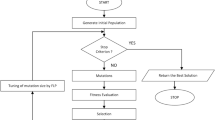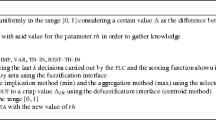Abstract
Genetic Algorithms (GAs) and other Evolutionary Algorithms (EAs), as powerful and broadly applicable stochastic search and optimization techniques have been successfully applied in the area of management science, operations research and industrial engineering. In the past few years, researchers gave lots of great idea for improvement of evolutionary algorithms, which include population initialization, individual selection, evolution, parameter setting, hybrid approach with conventional heuristics etc. However, though lots of different versions of evolutionary computations have been created, all of them have turned most of its attention to the development of search abilities of approaches. In this paper, for improving the search ability, we focus on how to take a balance between exploration and exploitation of the search space. It is also very difficult to solve problem, because the balance between exploration and exploitation is depending on the characteristic of different problems. The balance also should be changed dynamically depend on the status of evolution process. Purpose of this paper is the design of an effective approach which it can correspond to most optimization problems. In this paper, we propose an auto-tuning strategy by using fuzzy logic control. The main idea is adaptively regulation for taking the balance among the stochastic search and local search probabilities based on the change of the average fitness of parents and offspring which is occurred at each generation. In addition, numerical analyses of different type optimization problems show that the proposed approach has higher search capability that improve quality of solution and enhanced rate of convergence.
Similar content being viewed by others
References
Altiparmak F, Gen M, Dengiz B, Smith AE (2004) A network-based genetic algorithm for design of communication networks. J Soc Plant Eng Jpn 15(4): 184–190
Ahn CW, Ramakrishna R (2002) A genetic algorithm for shortest path routing problem and the sizing of populations. IEEE Trans Evol Comput 6(6): 566–579
Beasley JE, Christofides N (1989) An algorithm for the resource constrained shortest path problem. Networks 19: 379–394
Bonabeau E, Dorigo M, Theraulaz G (1999) Swarm intelligence: from natural to artificial systems. Oxford University Press, New York
Chatterjee A, Siarry P (2006) Nonlinear inertia variation for dynamic adaptation in particle swarm optimization. Comput Oper Res 33(3): 859–871
Clerc M (2006) Particle swarm optimization. ISTE
Cheong F, Lai R (2000) Constraining the optimization of a fuzzy logic controller using an enhanced genetic algorithm. IEEE Trans Syst Man Cyber B Cybern 30(1): 31–46
Davis L (ed) (1991) In: Handbook of genetic algorithms. Van Nostrand Reinhold, New York
Dengiz B, Altiparmak F, Smith AE (1997) Efficient optimization of all-terminal reliable networks using an evolutionary approach. IEEE Trans Reliability 46: 18–26
Deb K (2001) Multiobjective optimization using evolutionary algorithms. Wiley, Chichester
Dorigo M (1992) Optimization, learning and natural algorithms, PhD thesis. Politecnico di Milano, Italy
Dorigo M, Stutzle T (2004) Ant colony optimization. MIT Press, Cambridge
Fogel L, Owens A, Walsh M (1966) Artificial intelligence through simulated evolution. Wiley, New York
Gen M, Cheng R (1997) Genetic algorithms and engineering design. Wiley, New York
Gen M, Cheng R (2000) Genetic algorithms and engineering optimization. Wiley, New York
Gen M, Lin L (2005) Priority-based genetic algorithm for shortest path routing problem in OSPF. In: Proceedings of GECCO, Washington, D.C., USA
Goldberg D (1989) Genetic algorithms in search, optimization and machine learning. Addison-Wesley, Reading
Herrera F, Lozano M (1996) Adaptation of genetic algorithm parameters based on fuzzy logic controllers. In: Herrera F, Verdegay J (eds) Genetic algorithms and soft computing, Physica-Verlag, pp 95–125
Hinterding R, Michalewisz Z, Eiben A (1997) Adaptation in evolutionary computation: a survey. Proceedings of IEEE international conference on Evol. Computat., Piscataway, 65–69
Holland J (1992) Adaptation in natural and artificial system. University of Michigan Press, Ann Arbor, 1975. MIT Press, Cambridge
Hong TP, Wang HS (1996) A dynamic mutation genetic algorithm. Proc IEEE Int Conf Syst Man Cybern 3: 2000–2005
Hong TP, Wang HS, Lin WY, Lee WY (2002) Evolution of appropriate crossover and mutation operators in a genetic process. Appl Int 16: 7–17
Ishibuchi H, Murata T (1998) A multiobjective genetic local search algorithm and its application to flowshop scheduling. IEEE Trans Syst Man Cyber 28(3): 392–403
Julstrom B (1995) What have you done for me lately? Adapting operator probabilities in a steady-state genetic algorithm. Proceedings of the 6th international conference on GAs, San Francisco, pp 81–87
Koza JR (1992) Genetic Programming. MIT Press, Cambridge
Koza JR (1994) Genetic Programming II. MIT Press, Cambridge
Koumousis VK, Katsaras CP (2006) A saw-tooth genetic algorithm combining the effects of variable population size and reinitialization to enhance performance. IEEE Trans Evol Comput 10(1): 19–28
Lin L, Gen M (2006a) Bicriteria network design problem using interactive adaptive-weight GA and priority-based encoding method. IEEE Trans Evol Comput (submitting)
Lin L, Gen M (2006b) A self-control genetic algorithm for reliable communication network design. In: Proceedings of IEEE Congress on Evolutionary Computation, pp 2655–2662
Michael CM, Stewart CV, Kelly RB (1991) Reducing the search time of a steady state genetic algorithm using the immigration operator. In: Proceedings of IEEE international conference tools for AI, San Jose, pp 500–501
Michalewicz Z (1994) Genetic algorithm + data Structures = evolution programs. Springer, New York
Mathias KE, Whitley LD, Stork C, Kusuma T (1994) Staged hybrid genetic search for seismic data imaging. In: Proceedings of the evolutionary computation, pp 356–361
Mak KL, Wong YS, Wang XX (2000) An adaptive genetic algorithm for manufacturing cell formation. Int J Manuf Technol 16: 491–497
OR-Library. [Online]. Available: http://people.brunel.ac.uk/~mastjjb/jeb/info.html
Rechenberg I (1973) Optimieriung technischer Systeme nach Prinzipien der biologischen Evolution. Frommann-Holzboog, Stuttgart
Renders JM, Flasse SP (1996) Hybrid methods using genetic algorithms for global optimization. IEEE Trans Syst Man Cybern B Cybern 26(2): 243–258
Rogers D (1991) G/SPLINES: a hybrid of Friedman’s multivariate adaptive regression splines (MARS) algorithm with Holland’s genetic algorithm. In: Proceedings of the 4th international conference on genetic algorithms, pp 384–391
Schwefel H (1995) Evolution and optimum seeking. Wiley, New York
Srinvas M, Patnaik LM (1994) Adaptive probabilities of crossover and mutation in genetic algorithms. IEEE Trans Syst Man Cybern 24(4): 656–667
Song YH, Wang GS, Wang PT, Johns AT (1997) Environmental/economic dispatch using fuzzy logic controlled genetic algorithms. IEEE Proc Gener Transm Distrib 144(4): 377–382
Souza PS, Talukdar SN (1991) Genetic algorithm in asynchronous teams. In: Proceedings of the 4th international conference on genetic algorithms, pp 392–397
Subbu R, Sanderson AC, Bonissone PP (1998) Fuzzy logic controlled genetic algorithms versus tuned genetic algorithms: an Agile manufacturing application. In: Proceedings of the 1999 IEEE international symposium on intelligent control (ISIC), pp 434–440
Wang PT, Wang GS, Hu ZG (1997) Speeding up the search process of genetic algorithm by fuzzy logic. In: Proceedings of the 5th European congress on intelligent techniques and soft computing, pp 665–671
Wu QH, Cao YJ, Wen JY (1998) Optimal reactive power dispatch using an adaptive genetic algorithm. Electr Power Eng Syst 20(8): 563–569
Yun YS (2002) Hybrid genetic algorithm reinforced by fuzzy logic controller. J Korea Inst Ind Eng 28(1): 76–86
Yun YS, Gen M (2003) Performance analysis of adaptive genetic algorithms with fuzzy logic and heuristics. Fuzzy Optim Decis Mak 2(2): 161–175
Zitzler E, Thiele L (1999) Multiobjective evolutionary algorithms: a comparative case study and the strength Pareto approach. IEEE Trans Evol Comput 4(3): 257–271
Author information
Authors and Affiliations
Corresponding author
Rights and permissions
About this article
Cite this article
Lin, L., Gen, M. Auto-tuning strategy for evolutionary algorithms: balancing between exploration and exploitation. Soft Comput 13, 157–168 (2009). https://doi.org/10.1007/s00500-008-0303-2
Published:
Issue Date:
DOI: https://doi.org/10.1007/s00500-008-0303-2




